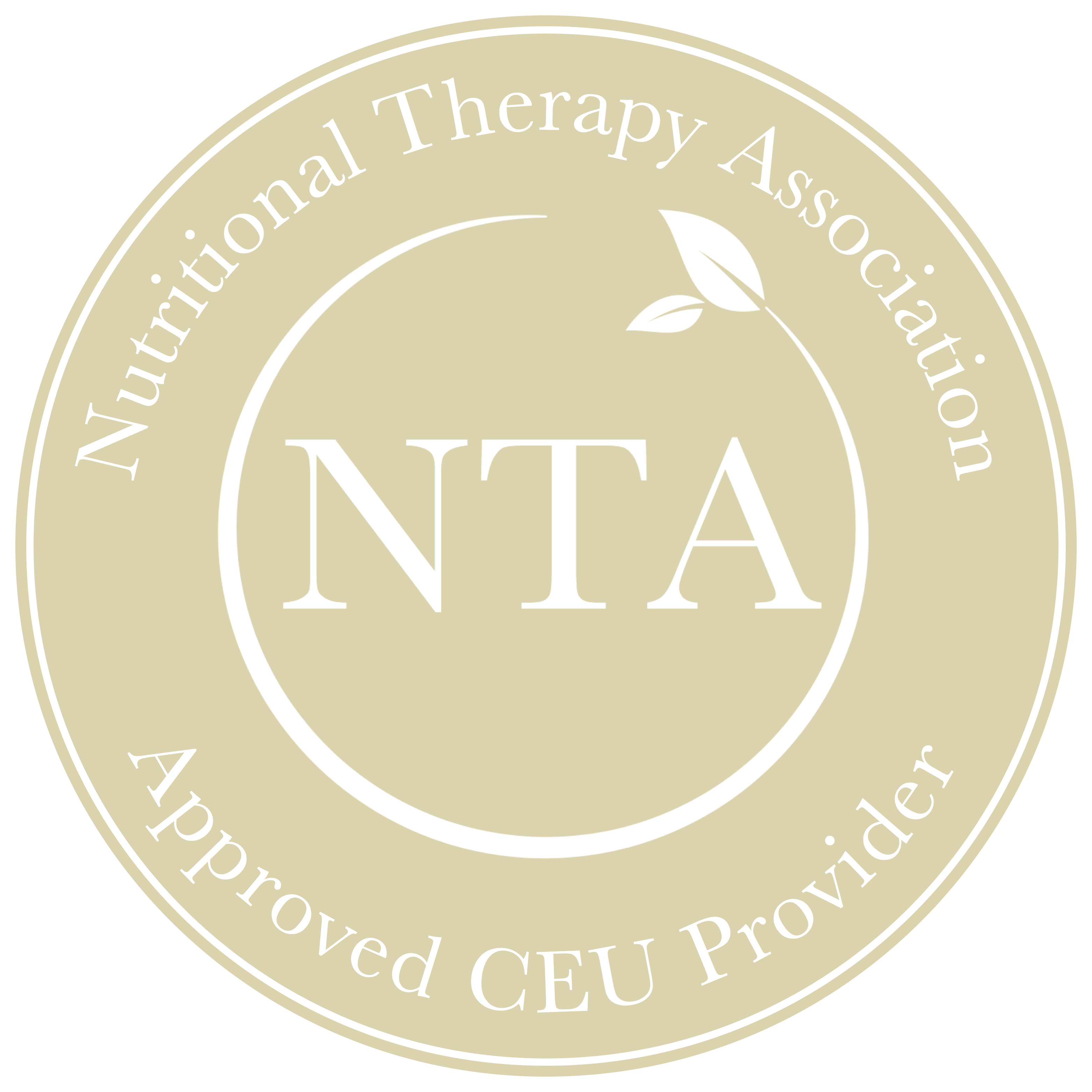If you've been anywhere near the holistic/functional nutrition world, you've likely heard of full moon parasite cleanses. The idea behind this type of cleanse is that host immunity is lowered during the full moon allowing parasites to be more active and therefore more available for targeted eradication.
Full moon parasite cleanses have caught on like wildfire throughout the holistic/functional nutrition world. But are these types of cleanses supported by actual literature?
Short answer, maybe. But testing whether a full moon cleanse has been effective or not presents a significant challenge.
What is a full moon parasite cleanse?
As the name implies, it’s a parasite cleanse timed around the full moon. Proponents recommend starting the cleanse right before the beginning of the full moon and finishing a few days after. The total cleanse can range from 3-7 days depending on a client's sensitivity. Some recommend starting with a shorter duration cleanse with lower-dose eradication agents, and then over time working up to a longer cleanse with higher dosing of eradication agents. Some practitioners recommend that clients go through foundational protocols first to prime detox capacity before undergoing the parasite cleanse. Nutritionally, they recommend a low to no sugar diet.
There are two main reasons proponents claim that parasite cleanses are most effective around the full moon. First, they state that there is a natural decrease in melatonin production during the full moon, thought to be caused by increased moonlight and subsequent light exposure. Simultaneously, there is an increase in serotonin production. The theory is that a decrease in melatonin lowers the host’s immune response, allowing parasites to proliferate, while serotonin stimulates parasite behavior and activity, increasing their movement and reproduction.
But does the literature around parasites actually support these claims?
Let's start with the claims about melatonin and serotonin.
Unpacking the Claims re: Melatonin and Serotonin
Melatonin:
Indeed, there is data showing that melatonin production declines in humans during the full moon (Cajochen et al., 2013). Research also shows that melatonin is an immune modulator, generally considered to enhance the body's immune response (although as an immune modulator it has the potential to be both anti-inflammatory and inflammatory) (Hardeland, 2018; Carrillo-Vico et al., 2013).
With decreased levels of melatonin around the full moon, and a resulting decrease in immune response, it's possible that increased parasite activity could occur at this time (Srinivasan et al., 2005). However, a stronger body of research suggests that melatonin acts as an anti-parasitic due to its role in immune activation. In fact, melatonin has been proposed as an anti-parasitic agent in and of itself for protozoan parasites infecting humans (Daryani et al., 2018; Bagnaresi et al., 2012).
If normal or elevated levels of melatonin can be anti-parasitic, it stands to reason that lower melatonin could conversely increase parasitic activity. But this is not strongly linked in available literature.
Serotonin:
There is stronger evidence showing that serotonin has a significant impact on parasite behavior and activity (Herz & Brehm, 2021; Mansour, 1985; Patocka et al., 2014). Although these are generally studies of parasites obtained through animal subjects.
This research demonstrates that parasite locomotion and behaviors are stimulated with elevated levels of serotonin due to activation of serotonin receptors located in the parasite's nervous system (Kreshchenko et al., 2021; Mansour, 1985). This also increases parasite development and proliferation. However, the serotonin surge around the full moon does not appear to be directly supported by available literature. Rather, the increase in serotonin seems to be extrapolated from data showing mood and behavioral changes around the full moon.
There is also evidence suggesting that parasites can take advantage of their host's (both animal and human) biological rhythms to increase their chances of survival and reproduction (Waxman-Boy et al., 2024). However, with regards to parasites specifically, this seems to have only been studied in relation to a 24-hour circadian rhythm and not a lunar cycle.
So even though there is some data that support both claims, there are a few problems.
How robust are these claims?
- How many studies support these claims? With regards to melatonin, there is significantly more evidence demonstrating anti-parasitic rather than parasite-enhancing properties. There is not strong evidence that lower melatonin levels aid in parasite development, reproduction, or feeding. Similarly, while some studies show that melatonin decreases during the full moon, the magnitude of this decrease is uncertain. This leaves the actual impact of decreased melatonin on the immune system similarly unclear.
- A serotonin surge around the full moon is not supported, so while multiple studies show increasing levels of serotonin lead to increased parasite activity, it's unclear whether there is any influence related to the full moon (Kreshchenko et al., 2021).
- Melatonin rhythms may be impacted by increased exposure to blue light and more time spent indoors, again possibly impacting its influence on the immune system.
- There is also evidence that parasites themselves can affect the immune system in humans regardless of melatonin and serotonin influences (Tsubokawa, 2023; Chulgnetra & Chaicumpa, 2021).
- Based on what we know about parasite lifecycles, a 3-7 day eradication is unlikely to be entirely effective. Even if most parasites can be killed during this one intensive phase, there will likely be stragglers and eggs remaining, and the parasite cycle will start over again quickly. Even multiple rounds of eradication are unlikely to capture a parasite’s entire lifecycle.
As such, based on the literature alone, full moon parasite cleanses are not compelling. Additionally, from our perspective at RWS, there are two glaring omissions.
What’s missed by full moon parasite protocols
Is the body prepared and ready for a parasite cleanse?
First, general full moon parasite cleanse protocols ignore the bio-individual foundational needs that are crucial to meet if any type of parasite cleanse (full moon or other) is going to be effective. Although some practitioners do recommend utilizing foundational protocols first, these are typically not bio-individual protocols based on lab testing, which is what we would recommend.
This is where RWS testing strategies provide essential information on the specific areas a client needs to address before undergoing any type of eradication protocol. It's not sufficient to suggest basic detox support and simple dietary changes; clients need to make significant dietary and lifestyle shifts first, as well as address underlying imbalances.
This is why we always recommend starting our work with the RWS Rebalancing Diet, stool testing, food sensitivity testing and comprehensive bloodwork.
The GI-MAP provides invaluable information about the health of the microbiome, the likelihood of gut permeability, and whether digestive function is optimized. If any of these dysfunctions are present, it's very unlikely that a parasite eradication protocol on its own will be successful. It can also indicate if certain parasites are actually present and warrant eradication.
The MRT food sensitivity test identifies inflammatory foods that damage the gut lining and impact the immune system, both essential components of priming the gut and immune system for successful eradication.
A Functional Blood Chemistry panel can also provide information about whether the body is ready to undergo an intensive parasite elimination protocol. For example, liver enzymes can help us evaluate a client’s ability to handle the stress of an eradication protocol. When elevated, we know that there is already significant underlying stress on the liver, and the liver is unlikely to be able to handle the increased burden of parasite eradication. Inflammatory markers, too, can give us an idea of the overall stress the body is already dealing with.
How do we know the cleanse was successful?
Secondly, how do we test effectiveness? From our standpoint we ideally want objective lab results pre- and post-protocol to assess whether our efforts have been effective. However, in order to measure this with regards to a full moon eradication, clients would need to collect two samples within one week or less to encompass pre- and post-cleanse. Having a client complete two stool samples in such a short time would not only present an excessive cost, but clients are also very unlikely to agree to this level of aggressive testing.
Proponents of this protocol argue that this protocol works and they're not relying on testing. So how are they gauging the success of the full moon cleanse? These practitioners argue that a visual increase in parasites eliminated through the stool demonstrates the cleanse's effectiveness.
However, while clients may see increased parasite-like samples in their stool, the only way to know for sure if these are actually parasites is for a trained parasitologist to identify the specimens, likely with the use of a microscope, or through stool testing.
There are a huge number of these pictures circulating the internet, where clients and practitioners show stool excretions and identify them as various parasites. Looking closely at the photos, these “parasites” are nearly indistinguishable from undigested food particles, mucus, or sloughed-off intestinal lining (which can be caused by some herbs like Mimosa Pudica). We just can't know for sure without either the input of a specialist or stool testing.
Instead of a full moon parasite cleanse, we recommend the following:
- If your client is interested in doing a parasite cleanse, make sure to prepare appropriately with a stool test such as the GI-MAP and MRT food sensitivity test at minimum, and Functional Blood Chemistry analysis if possible.
- Create a protocol that captures the entire lifecycle of the parasite in question. Our protocols typically last a full 12 weeks and may need to be extended if parasites remain on retest or if symptoms have not fully resolved. For worms, we recommend pulsing eradication agents to capture the full reproductive lifecycle.
- Additional testing may also be needed. While the GI-MAP captures some parasite species, if parasites are highly suspected we may refer clients to other lab testing options such as Parawellness Research. As opposed to the GI-MAP, Parawellness primarily uses microscopy to examine stool and urine samples looking exclusively for parasites. Therefore, it has a greater capacity to capture a wider variety of parasitic species. Parawellness also recommends specific antiparasitic agents that target the exact parasites showing up in the lab results.
What if your client is dead set on a full moon cleanse?
If you have a client who insists on a full moon parasite cleanse is there possible harm?
If a client's foundational needs have been met, then probably not. Anecdotal evidence demonstrates that many clients find these cleanses to be highly effective in terms of symptom reduction. This is one of the main reasons these cleanses have become so popular.
It's likely that short-term eradication does relieve some of the burden parasites have on the body, which results in the reported symptom relief. However, based on what we know about parasite lifecycles, the 3-7 day period of the full moon cleanse is probably not going to be sufficient for a comprehensive and lasting parasite eradication. Many full moon cleanse instructions recommend repeating this protocol multiple times throughout the year. Additionally, we know that parasites can become resistant to eradication agents. Continuously using the same eradication protocol each month without ensuring complete eradication greatly increases the probability that any species present will become resistant to these products, reducing their effectiveness over time.
Conclusions from the literature:
What’s the bottom line?
Some research supports the basic biological mechanisms surrounding full moon parasite cleanses. However, the actual effect of the full moon on parasite activity has not been conclusively demonstrated by the available literature. The short duration of these protocols is also unlikely to successfully eradicate a parasitic infection even if symptoms are briefly alleviated. Lastly, without testing, we really have no way to know if a protocol has been effective.
Proponents state, “the proof is in the toilet.” But for us, the proof is in the lab testing. And we just don't have that.
References:
- Bagnaresi, P., Nakabashi, M., Thomas, A. P., Reiter. R. J., & C. R. S. Garcia. The role of melatonin in parasite biology. (2012). Molecular and Biochemical Parasitology. 181(1):1-6. https://doi.org/10.1016/j.molbiopara.2011.09.010
- Cajochen, C., Altanay-Ekici, S., Münch, M., Frey, S., Knoblauch, V., & A. Wirz-Justice. Evidence that the lunar cycle influences human sleep. (2013) Current Biology, 23(15):1485-8. 10.1016/j.cub.2013.06.029
- Carrillo-Vico, A. Lardone, P. J., Alvarez-Sanches, N. Rodriguez-Rodriguez, A., & J. M. Guerrero. Melatonin: Buffering the Immune System (2013). International Journal of Molecular Science, 14(4): 8638-8683. 10.3390/ijms14048638
- Chulgnetra, M. & W. Chaicumpa. Revisiting the Mechanisms of Immune Evasion Employed by Human Parasites. (2021) Frontiers in Cellular and Infection Microbiology, 11. 10.3389/fcimb.2021.702125
- Daryani, A., Montazeri, M., Pagheh, A. S., Sharif, M., Sarvi, S., Hosseinzadeh., A. Reiter. R. J., Hadighi, R., Joghataei, M. T., Ghaznavi, H., & S. Mehrzadi (2018). The potential use of melatonin to treat protozoan parasitic infections: A review. Biomedicine & Pharmacotherapy, 97, 948-957. https://doi.org/10.1016/j.biopha.2017.11.007
- Hardeland, R. Melatonin and inflammation—Story of a double-edged blade (2018). Journal of Pineal Research, 65(4). https://doi.org/10.1111/jpi.12525
- Herz, M., & K. Brehm. Serotonin stimulates Echinococcus multilocularis larval development. (2021). Parasites & Vectors. 14. 10.1186/s13071-020-04533-0
- Kreshchenko, N., Terenina, N., & A. Ermakov. Serotonin Signalling in Flatworms: An Immunocytochemical Localisation of 5-HT7 Type of Serotonin Receptors in Opisthorchis felineus and Hymenolepis diminuta. (2021). Biomolecules, 11(8). https://doi.org/10.3390/biom11081212
- Mansour, T.E. Serotonin receptors in parasitic worms. (1985). Advances in Parasitology. 23: 1-36. 10.1016/S0065-308X(08)60284-5
- Patocka, N., Sharma, N., Rashid, M., & P. Ribeiro. Serotonin Signaling in Schistosoma mansoni: A Serotonin–Activated G Protein-Coupled Receptor Controls Parasite Movement. (2014). PLOS Pathogens. 10(1). 10.1371/journal.ppat.1003878
- Srinivasan, V., Maestroni, G.J.M, Cardinali, D.P., Esquifino, A.I., Pandi Perumal, S.R., & S.C. Miller. Melatonin, immune function and aging (2005). Immunity & Ageing, 17. 16316470
- Tsubokawa, D. Immunomodulators secreted from parasitic helminths act on pattern recognition receptors. (2022). Frontiers in Parasitology. https://doi.org/10.3389/fpara.2022.1091596
- Waxman-Boy, S., Olivier, M., & N. Cermakian. Clockwork intruders: Do parasites manipulate their hosts' circadian rhythms? (2024). Current Research in Parasitology & Vector-Borne Diseases, 5. https://doi.org/10.1016/j.crpvbd.2024.100171
ABOUT THE AUTHOR

Kimme Rovin, Instructor, FNTP, RWP-3
Kimme’s path into functional nutrition started with medical anthropology where she spent years studying how culture shapes health, especially infant feeding and child nutrition practices across southern and eastern Africa. Her passion for public health led her to earn a Master of Public Health degree with a focus on maternal and child health and a PhD in Medical Anthropology. But it wasn’t until she faced her own health challenges that she started exploring nutrition on the individual level.
Like many of the women she now supports, Kimme found herself navigating a complex web of symptoms that conventional medicine struggled to explain. This frustration sparked a deep dive into functional nutrition, where she finally discovered a framework that honored the full picture: body, environment, and lived experience. She became a Nutritional Therapy Practitioner in 2018 and continued her advanced training through Restorative Wellness Solutions, completing Levels 1, 2, and 3. Today, she’s proud to serve as an instructor, guiding other practitioners in building their skills and confidence.
In her own practice, Kimme is especially passionate about helping women with chronic health conditions regain their energy, mood balance, and intuitive connection to their bodies. Her approach is rooted in a belief that healing is not just physical, and she loves to explore the subtle ways our internal world and physiology are intricately linked.
Outside of her practice, Kimme loves running in the Boise foothills and painting tiny animals onto river stones. She has two daughters, an elderly guinea pig, and a fluffy white dog.






